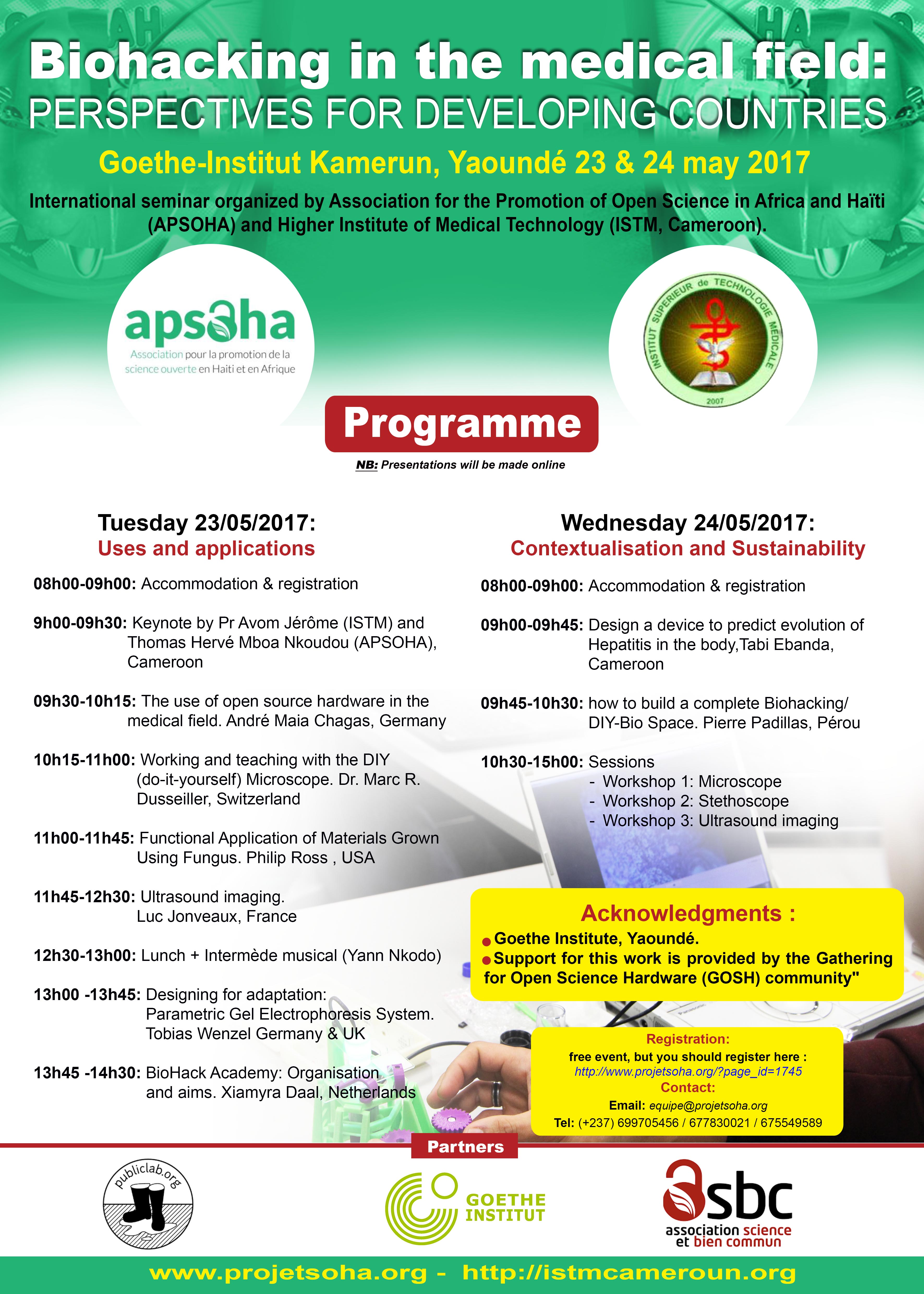« Le Biohacking dans le domaine médical: perspectives pour les pays en voie de développement »
Yaoundé, 23 et 24 Mai 2017
Inscrivez-vous gratuitement en écrivant à equipe@projetsoha.org
Présentations
1- The use of open source hardware in the medical field
Présenté par : André Maia Chagas, Germany
I’m André M Chagas, retina researcher by day and full time open source advocate. I’m involved in a couple of projects related to open science and open hardware in general: I run a website: open neuroscience3, where I gather interesting open source projects related to neurosciences. I collaborate with an NGO called Trend in Africa (trendinafrica.org), where we try to help development in the continent by through several projects. The one I’m most involved with are workshops on Basic electronics and 3D printing to empower researchers to build their own lab equipment and/or hack existing ones. Last but not least, again together with Trend, we developed a microscope based on a Raspberry Pi and Arduino. It can be used for microscopy and behavioural experiments with small invertebrates. We like to call it Flypi3.
Résumé
I would talk about the use of open source hardware in the medical field. For example, how the use of DIY microscopes can lead to faster and locally available diagnostics. Another example is this 5 Dollar stethoscope that can perform as well as very expensive models. Last but not least, one could talk about 3D printing technologies for teaching in anatomy and surgery preparation
2- Working and teaching with the DIY (do-it-yourself) Microscope.
Presenté par: Dr. Marc R. Dusseiller, Switzerland/Global
Co-founder of Hackteria | Open Source Biological Art.
Marc Dusseiller aka dusjagr is a nomadic researcher and workshopologist. He is part of the Center for Alternative Coconut Research and co-founder of SGMK and the Hackteria network. He performs DIY (do-it-yourself) workshops in lo-fi electronics and synths, hardware hacking for citizen science and DIY microscopy.
Résumé
Through a simple hack of the optics of any cheap and broadly accessible webcam, anyone can build a « good-enough » microscope to be used for educational activites, aswell to a limited extent as citizen science projects for environmental monitoring and medical diagnostics. I will present pedagogic approaches to be applied with the DIY microscopes for creative making skills, biodiversity awareness, standard biology/anatomy classes and gender biopolitcs. http://www.hackteria.org/wiki/DIY_microscopy#Instructions hackteria @ POC Diagnostics Workshop, Kenya
3- Functional Application of Materials Grown Using Fungus
Présenté par Philip Ross
Philip Ross is an artist, inventor, and scholar research is focused on biomaterial design and life support technologies. He is a co-founder and CTO of MycoWorks, a San Francisco start-up that turns mycelium (the threadlike, vegetative part of mushrooms) into leather and other materials– using carbon-neutral, organic, biodegradable and fully sustainable technology. Philip also serves as a bioengineering scholar at Stanford University, where he is working to develop an internet of biological things.
Résumé
In this presentation, Philip Ross will describe the histories and practices that led to the use of fungus as a contemporary material for industrial applications. This will describe the basic biology of fungi, the craft of growing materials as a form of production, and a demonstration of possible products that can be generated in this manner. This talk will illuminate the challenges of bringing new biological materials into being, and some paths towards initial experiments and research that are appropriate to the needs of the people of Camaroon.
https://www.youtube.com/watch?v=jBXGFOk5_Rs&t=23s
4- Ultrasound imaging
Présenté par: Luc Jonveaux, France
Résumé
This project has a specific target of providing a low-cost, open source technological kit to allow scientists, academics, hackers, makers or OSHW fans to hack their way to ultrasound imaging – below 500$ – at home, with no specific equipment required. Article : http://openhardware.metajnl.com/articles/10.5334/joh.2/ Full doc: https://kelu124.gitbooks.io/echomods/content/
5- Designing for adaptation: Parametric Gel Electrophoresis System
Présenté par: Tobias Wenzel (Germany)
Tobias Wenzel is a bioengineer at the University of Cambridge, founder of the free open hardware documentation software and repository DocuBricks: http://www.docubricks.com/2.
Résumé
Gel electrophoresis systems are one of the most common tools of scientists working with DNA in experiments. Yet existing commercial solutions are expensive and non-customizable. Gel electrophoresis systems do not follow many standards so with the open source parametric system presented here, there is nothing that stops you from building a gel system in the size that most suits your needs – for a fraction of the prize of a commercial system. This gel system was designed to be of research grade quality, safe, easy to build and easy to modify. http://www.docubricks.com/2
6- BioHack Academy: Organisation and aims.
Présenté par: Xiamyra Daal
Xiamyra Daal is concept developer at the Open Wetlab of Waag Society. She coordinates the Do It Together Bio workshops and guides the Open Wetlab evenings, where she shares her fascination and enthusiasm for biology with everybody. Xiamyra studied Biomedical Sciences in Leiden during which she gained her laboratory experience. Xiamyra loves to make things herself. Currently she is building her own lab at home.
7 – Design a device to predict evolution of Hepatitis in the body
Présenté par: Tabi Ebanda, Cameroon
8- How to build a complete Biohacking/DIY-Bio Space
Présenté par Pierre Padillas, Pérou
I’m a researcher in Biomedical Informatics in Global Health at Universidad Peruana Cayetano Heredia (UPCH). I support networks as Peru Coordinator in SyntechBio and Open Biomedical Initiative2. I’m also the Founder and Director of Biomakers Lab1, a Peruvian biohackerspace where we promote and develop biology in a more accessible way for scientists, biohackers, amateurs or anyone which might be interested in this field.
résumé
Our last project was a Manual called The Essential Biohacker’s Guide2 with SyntechBio. We grouped basic information about how to build a complete Biohacking/DIY-Bio Space.
Workshops




